Benzene was isolated by Michael Faraday in 1825. The molecular formula of benzene, C6H6, indicates a high degree of unsaturation. This molecular formula did not account for its relationship to corresponding alkanes, alkenes and alkynes which you have studied in earlier sections of this unit. What do you think about its possible structure? Due to its unique properties and unusual stability, it took several years to assign its structure. Benzene was found to be a stable molecule and found to form a triozonide which indicates the presence of three double bonds. Benzene was further found to produce one and only one monosubstituted derivative which indicated that all the six carbon and six hydrogen atoms of benzene are identical. On the basis of this observation August Kekulé in 1865 proposed the following structure for benzene having cyclic arrangement of six carbon atoms with alternate single and double bonds and one hydrogen atom attached to each carbon
atom.
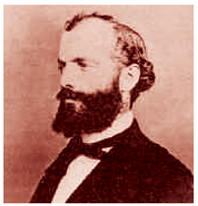
FRIEDRICH AUGUST
KEKULÉ
(7th September 1829–13th July 1896)
Friedrich August Kekulé,a German chemist was born in 1829 at Darmsdt in Germany. He became Professor in 1856 and Fellow of Royal Society in 1875. He made major contribution to structural organic chemistry by proposing in 1858 that carbon atoms can join to one another to form chains and later in 1865,he found an answer to the challenging problem of benzene structure by suggesting that these chains can close to form rings. He gave the dynamic structural formula to benzene which forms the basis for its modern electronic structure. He described the discovery of benzene structure later as:
“I was sitting writing at my textbook,but the work did not progress; my thoughts were elsewhere. I turned my chair to the fire, and dozed. Again the atoms were gambolling before my eyes. This time the smaller groups kept modestly in the background. My mental eye, rendered more acute by repeated visions of this kind, could now distinguish larger structures of manifold conformations; long rows,sometimes more closely fitted together; all twisting and turning in snake like motion. But look! What was that? One of the snakes had seized hold of it’s own tail, and the form whirled mockingly before my eyes. As if by a flash of lightning I woke;.... I spent the rest of the night working out the consequences of the hypothesis. Let us learn to dream, gentlemen, and then perhaps we shall learn the truth but let us beware of making our dreams public before they have been approved by the waking mind.”( 1890).
One hundred years later, on the occasion of Kekulé’s centenary celebrations a group of compounds having polybenzenoid structures have been named as Kekulenes.
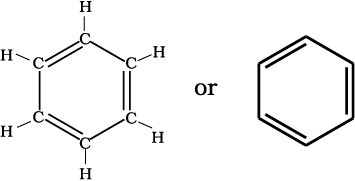
The Kekulé structure indicates the possibility of two isomeric 1, 2-dibromobenzenes. In one of the isomers, the bromine atoms are attached to the doubly bonded carbon atoms whereas in the other, they are attached to the singly bonded carbons.
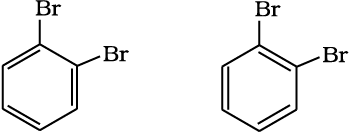
However, benzene was found to form only one ortho disubstituted product. This problem was overcome by Kekulé by suggesting the concept of oscillating nature of double bonds in benzene as given below.
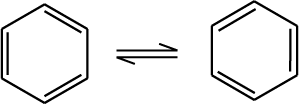
Even with this modification, Kekulé structure of benzene fails to explain unusual stability and preference to substitution reactions than addition reactions, which could later on be explained by resonance.
Resonance and stability of benzene
According to Valence Bond Theory, the concept of oscillating double bonds in benzene is now explained by resonance. Benzene is a hybrid of various resonating structures. The two structures, A and B given by Kekulé are the main contributing structures. The hybrid structure is represented by inserting a circle or a dotted circle in the hexagon as shown in (C). The circle represents the six electrons which are delocalised between the six carbon atoms of the benzene ring.

(A) (B) (C)
The orbital overlapping gives us better picture about the structure of benzene. All the six carbon atoms in benzene are sp2 hybridized. Two sp2 hybrid orbitals of each carbon atom overlap with sp2 hybrid orbitals of adjacent carbon atoms to form six C—C sigma bonds which are in the hexagonal plane. The remaining sp2 hybrid orbital of each carbon atom overlaps with s orbital of a hydrogen atom to form six C—H sigma bonds. Each carbon atom is now left with one unhybridised p orbital perpendicular to the plane of the ring as shown below:
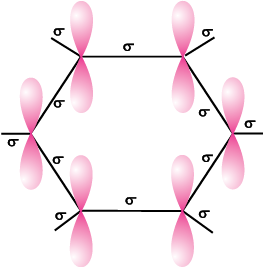
The unhybridised p orbital of carbon atoms are close enough to form a π bond by lateral overlap. There are two equal possibilities of forming three π bonds by overlap of p orbitals of C1 –C2, C3 – C4, C5 – C6 or C2 – C3, C4 – C5, C6 – C1 respectively as shown in the following figures.
Structures shown in Fig. 13.7(a) and (b) correspond to two Kekulé’s structure with localised π bonds. The internuclear distance between all the carbon atoms in the ring has been determined by the X-ray diffraction to be the same; there is equal probability for the p orbital of each carbon atom to overlap with the p orbitals of adjacent carbon atoms [Fig. 13.7 (c)]. This can be represented in the form of two doughtnuts (rings) of electron clouds [Fig. 13.7 (d)], one above and one below the plane of the hexagonal ring as shown below:
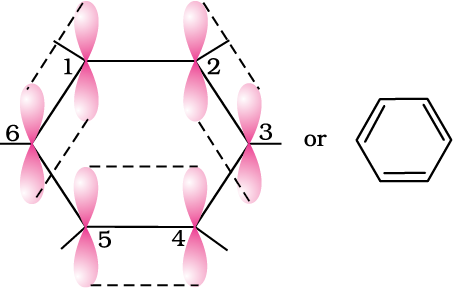
Fig. 13.7 (a)
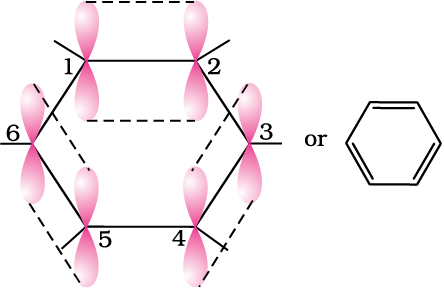
Fig. 13.7 (b)
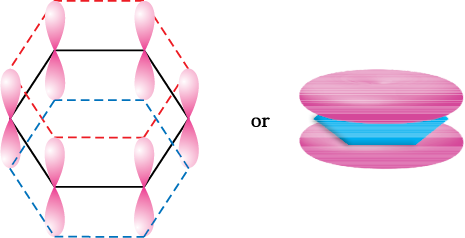
Fig. 13.7 (c) Fig. 13.7 (d)
The six π electrons are thus delocalised and can move freely about the six carbon nuclei, instead of any two as shown in Fig. 13.6 (a) or (b). The delocalised π electron cloud is attracted more strongly by the nuclei of the carbon atoms than the electron cloud localised between two carbon atoms. Therefore, presence of delocalised π electrons in benzene makes
it more stable than the hypothetical cyclohexatriene.
(electron cloud)
X-Ray diffraction data reveals that benzene is a planar molecule. Had any one of the above structures of benzene (A or B) been correct, two types of C—C bond lengths were expected. However, X-ray data indicates that all the six C—C bond lengths are of the same order (139 pm) which is intermediate between C— C single bond (154 pm) and C—C double bond (133 pm). Thus the absence of pure double bond in benzene accounts for the reluctance of benzene to show addition reactions under normal conditions, thus explaining the unusual behaviour of benzene.